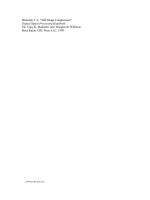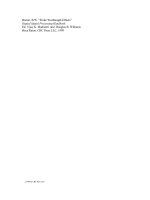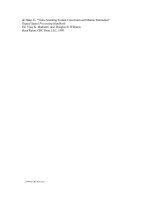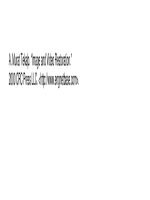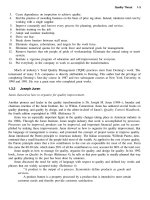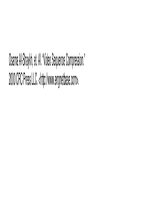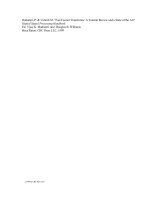Drilling Fluids Processing Handbook P2
Bạn đang xem bản rút gọn của tài liệu. Xem và tải ngay bản đầy đủ của tài liệu tại đây (1.53 MB, 10 trang )
This page intentionally left blank
CHAPTER 2
DRILLING FLUIDS
Fred Growcock
M-I SWACO
Tim Harvey
Oiltools, Inc.
2.1 DRILLING FLUID SYSTEMS
2.1.1 Functions of Drilling Fluids
A drilling fluid, or mud, is any fluid that is used in a drilling operation
in which that fluid is circulated or pumped from the surface, down the
drill string, through the bit, and back to the surface via the annulus.
Drilling fluids satisfy many needs in their capacity to do the following
[M-I llc]:
.
Suspend cuttings (drilled solids), remove them from the bottom of the
hole and the well bore, and release them at the surface
.
Control formation pressure and maintain well-bore stability
.
Seal permeable formations
.
Cool, lubricate, and support the drilling assembly
.
Transmit hydraulic energy to tools and bit
.
Minimize reservoir damage
.
Permit adequate formation evaluation
.
Control corrosion
15
.
Facilitate cementing and completion
.
Minimize impact on the environment
.
Inhibit gas hydrate formation
The most critical function that a drilling fluid performs is to minimize
the concentration of cuttings around the drill bit and throughout the well
bore. Of course, in so doing, the fluid itself assumes this cuttings burden,
and if the cuttings are not removed from the fluid, it very quickly loses its
ability to clean the hole and creates thick filter cakes. To enable on-site
recycling and reuse of the drilling fluid, cuttings must be continually and
efficiently removed.
2.1.2 Types of Drilling Fluids
Drilling fluids are classified according to the type of base fluid and other
primary ingredients:
.
Gaseous: Air, nitrogen
.
Aqueous: Gasified—foam, energized (including aphrons)
Clay, polymer, emulsion
.
Nonaqueous: Oil or synthetic—all oil, invert emulsion
True foams contain at least 70% gas (usually N
2
,CO
2
, or air) at the
surface of the hole, while energized fluids, including aphrons, contain
lesser amounts of gas. Aphrons are specially stabilized bubbles that
function as a bridging or lost circulation material (LCM) to reduce mud
losses to permeable and microfractured formations. Aqueous drilling
fluids are generally dubbed water-based muds (WBMs), while non-
aqueous drilling fluids (NAFs) are often referred to as oil-based muds
(OBMs) or synthetic-based muds (SBMs). OBMs are based on NAFs
that are distilled from crude oil; they include diesel, mineral oils, and
refined linear paraffins (LPs). SBMs, which are also known as pseudo–
oil-based muds, are based on chemical reaction products of common
feedstock materials like ethylene; they include olefins, esters, and
synthetic LPs.
Detailed classification schemes for liquid drilling fluids are employed
that describe the composition of the fluids more precisely. One such
classification scheme is shown in Figures 2.1 and 2.2. An even more
precise classification scheme is described in Table 2.1, which includes
16 Drilling Fluids Processing Handbook
the mud systems most commonly used today, along with their principal
components and general characteristics [adapted from Darley & Gray].
2.1.3 Drilling Fluid Selection
Drilling-fluid costs can constitute a significant fraction of the overall
costs of drilling a well. Often the cost is quoted per unit length drilled,
which takes into account any problems encountered (and avoided), such
as stuck pipe. In many cases, the cost ascribed to the fluid also includes
costs associated with solids control/management and waste disposal.
Soluble
Additives
Fresh
Water
Ca
2+
, Mg
2+
Cl
−
, Br
−
Sea
Water
Na
+
, K
+
, Ca
2+
Cl
−
, Br
−
, HCOO
−
Saline Solution
Water
Commercial Clays
Polymers
Chemicals
Low Gravity
Weight Material
Insoluble Salts
(CaCO
3
)
High Gravity
Mud System
Components
Smectite Clays
Reactive
Sand
Limestone
Other minerals
Inert
Drilled
Solids
Solids
Figure 2.1. Types of Water-Based Muds.
Surfactants
Rheology Modifers
Polymers
Thinners
Oil Soluble
Liquid Additives
Diesel Oil
Mineral Oil
Refined LP's
Oil Base
Fluid
Olefins
Esters
Synthetic LP's
Synthetic
Fluid
External
Phase
Ca
2+
and OH
−
from Lime
Non-Chloride
Activity Reducers:
Glycols, Acetates,
Nitrates
Internal
Phase
Organophilic Clay
Weight Material
Salt (CaCO
3
)
FLC Additives
System
Components
Clays
Sand
Limestone
Drilled
Solids
Solids
CaCl
2
to reduce
water activity
Figure 2.2. Types of Invert-Emulsion Muds.
FLC ¼ ferroelectric liquid crystals.
Drilling Fluids 17
Table 2.1
Classification of Drilling Fluid Systems
Mud Type Principal Components General Characteristics
Aqueous
Simple freshwater Freshwater Low cost, onshore applications; fast drilling in
stable formations; need space for solids settling,
flocculants may be used
Simple seawater Seawater Low cost, offshore applications
Spud mud Bentonite, water Low cost, surface hole
Saltwater Seawater, brine or saturated saltwater; saltwater
clay, starch, cellulosic polymer
Moderate cost, drilling salt and workovers
Lime or gyp Fresh or brackish water; bentonite, lime, or
gypsum, lignosulfonate
Moderate cost, shale drilling; simple maintenance,
high temp, tolerance to salt, anhydrite, cement,
drilled solids
Lignite or lignosulfonate
(chrome or chrome free)
Fresh or brackish water; bentonite, caustic, lignite
or lignosulfonate
Moderate cost, shale drilling; simple maintenance,
high temp, tolerance to salt, anhydrite, cement
Potassium Potassium chloride; acrylic, bio or cellulosic
polymer, some bentonite
Moderate cost, hole stability; low tolerance to
drilled solids, high pH
Low solids (‘‘nondispersed’’
when weighted up)
Fresh to high saltwater; polymer, some bentonite High cost, hole stability; low tolerance to drilled
solids, cement and divalent salts
18DrillingFluidsProcessingHandbook
